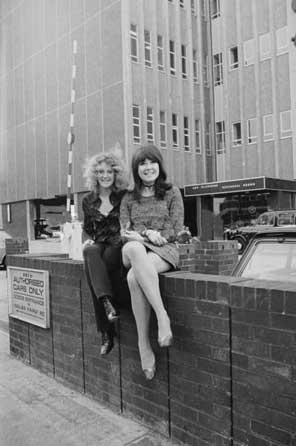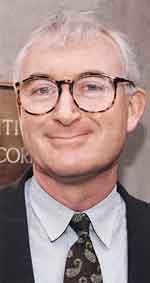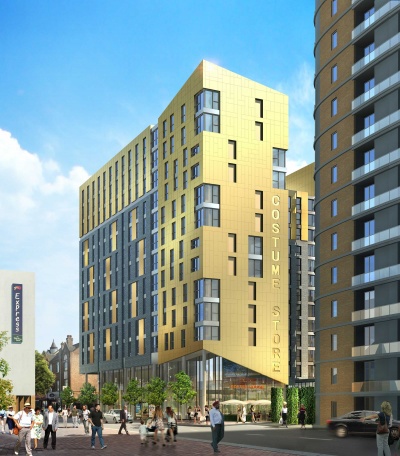

When the Television Rehearsal Rooms entered service, demand for the facility
was probably at its height. Not only were there 18 rooms in the new building,
the "Acton Hilton" as it was dubbed, but about 15 external rooms were
still being leased, – and filled at peak times. Drama, Light Entertainment
– both Variety and Comedy, and also a smattering of other departments
such as Schools and Children's kept North Acton buzzing.
On the opening day 4th May 1970, you could find a 30 Minute Theatre starring
Patrick Wymark, Dr Finlay, Codename, Up Pompeii, Brian Rix & Elspet Gray
in a 'Gala Performance', and Dad's Army. The Acton Gazette and Post
ran a feature celebrating this glamorous addition to their usual diet of local
news. (see
article)

The Acton rehearsal rooms were very popular, artistes would even pose outside
them for publicity photos. They were also good places to meet other actors either
in the restaurant or in The Castle pub, a few doors down. Towards the end of
the rehearsal session would come the 'Tech Run' and the car park on Victoria
Road swelled with Lighting, Sound, and other studio staff taking notes to prepare
their studio plans.
Technical advances so far had had little effect on the way these shows rehearsed.
Even the arrival of videotape editing had not radically altered the way the
material was shot, although compared with 'live' it was becoming more common
to record a group of scenes, and sometimes to shoot scenes out of order, to
aid studio logistics. Re-takes, if anything, drove up the quality of the final
product, rather than encouraging under-rehearsed shows to be televised.
During the seventies viewing figures dropped for the single play format. The
strands which contained them fizzled out (Wednesday Play -1970, Play for Today
-1984, 30 Min Theatre-1973, ITV's Armchair Theatre -1974) and consequently there
were fewer and fewer made. Colour lent a greater interest to settings and costumes
and the film inserts into dramas which at one time had been a heaven-sent opportunity
to change costumes and drive cameras and booms to a new set, now took on a life
of their own with viewers enjoying settings impossible to re-construct in the
studio.
Variety programmes in which a star or stars perform comedy sketches, dance,
singing, in a very theatrical format, only achieved top viewing figures if they
could offer incomparable performers.
In 1984 the BBC acquired
Elstree Studios (Clarenden Road Studios Boreham Wood). Four studios, 3? rehearsal
rooms and an extensive lot which had last been used by ATV for Auf Wiedersehen
Pet. It had been decided, at long last, to try to match the success of Granada's
Coronation Street. Julia Smith, Tony Holland and their team launched EastEnders
on the airwaves in February 1985 as two episodes per week, exteriors shot on
the lot at Elstree and with a studio with a number of fixed sets and extra sets
rotated in as the story focus shifted. Shooting in the studio was conventional
multi-camera and on the lot were two cameras cut into a mobile VT. She made
use of one of the rehearsal rooms which were on site. Another continuing drama
also used Elstree as its base, Grange Hill, and this rehearsed in another room
on that site.
By 1985 there were less bookings for outside rehearsal rooms and only five external
rooms were needed on the list of approved rehearsal premises, – strangely
retaining two of the least safe locations in London, both in North Kensington.
[see
Studio Management sheet]
In 1986 Casualty established what has become a standard operation for continuing
drama, a warehouse operation with standing sets, EastEnders with three episodes
per week from 1994 followed suit on the Elstree site and Holby City likewise.
None of these dramas used external rehearsal facilities, the sets being available
under house-lights for rehearsing if that was required. In a reversal of previous
policy, in early 1990 the BBC under the direction of Michael Checkland purchased
the freehold and buildings on much of the Gipsy Corner site including TRR.
Changes in technology meant
cameras using chips rather than tubes, and recorders became simpler and less
costly. The whole process of 'televising' had ceased to be dominated by engineering
constraints, but became part of the general production process. If it was better
to rehearse a section on set then record it, that was the way it was done. If
the next section called for single camera shooting, as in film work, then that
would be used.

Despite these factors, in 1992 TRR still showed a pretty healthy utilisation, around 80%. [see booking sheet] But change was in the air, the licence fee settlement had demanded that the BBC move towards 25% of programmes being made by independents. This seems to have hit comedy particularly hard, perhaps because other genres contained programmes which the BBC felt at that time had to be made in-house if the BBC was to mean anything. The other change in 1992 was the ascendancy of John Birt to become Director General. His big push was the implementation of "Producer Choice", a well-intentioned mechanism to try to contain the cost inflation of in-house programme making and also to encourage BBC's resources to offer a better service to productions - the customers. The theory was that a production could elect to use any mixture of internal or external facilities, they had a cash budget and the power to choose. The next year saw the BBC leaking money very badly as across the board, productions found they could buy a facility such as studios a little bit cheaper on the open market so saving let's say 10%, while the Corporation was still faced with the bill for that empty studio. The implementation of Producer Choice was very costly as it was not possible to dispose of assets and staff with the speed which would have been necessary to make any real savings.
There were other factors that began to come into play, perhaps as a result
of the wider creative input which the independents brought. Situation comedy,
'sitcoms', had an established format and BBC Light Entertainment department,
– through several changes of management – had allowed few departures
from the tradition of a complete programme recorded with sets in the studio
in front of a studio audience. Last of the Summer Wine was an exception in having
the bulk of its material shot on location. Over the years, an increasing minority
of writers and performers felt there ought to have been room for an alternative:
comedy made in the fashion of a drama, transmitted without an audience's laughter,
and perhaps more importantly, written without the need to cater for that studio
audience, – going for the comedy of the character rather than the
gag line. This type of programme would frequently dispense with the outside
rehearsal, and even shoot entirely on location, so no studio either! From the
mid 90's this sort of comedy has flourished. [extract
from Carla Lane's book]
Television Rehearsal Rooms fared very badly under these changes, many programmes
were now made independently, and TRR was a costly facility, roughly £1
million a year (rates alone were £206,800 in 2007). Its competitors, the
church halls and boys' clubs had always been cheaper, they were after all there
for another purpose and any money made in daytime sales to television was a
bonus. They also, having charitable status, received an 80% discount on business
rates.
In an effort to stem the losses, in 1995 the lower three floors of TRR were
converted into storage areas for BBC Wardrobe and Wigs, two other facilities
also having difficulty under the new arrangements. Demand for rehearsal facilities
was still in decline however and in 1997 and 1998 the remaining floors were
converted for office use, including air conditioning..
At the end of 2007, part of the office space was cleared on the fourth floor
and a couple of programmes, including 2 Pints were allowed to rehearse there.
In April 2008 Wardrobe and Wigs having been sold off from BBC Resources, the
premises became empty. BBC offered the charity "Crisis at Christmas"
the use of the building to provide a short-term hostel for London's homeless
at the end of 2008.

At the start of 2009, TRR remained empty. The BBC decided to sell it at the
bottom of the recession, a weak market for industrial buildings, finally allowing
it to be bought by Carphone Warehouse. They in turn immediately sold it on to
Berkeley First and University of the Arts London. The new building will contain
718 student accommodation units for the University of the Arts. It will include
commercial premises at ground floor level. It is to be called The Costume Store.
According to Fullers, the brewery, The Castle pub will stay much as it is, but the many pictures of the stars of the Acton Hilton which used to adorn the pub's walls are already long gone.
TRR was carefully demolished over the summer of 2010 and foundation work began on its successor. (shown left)
Some pictures of the demolition of TRR